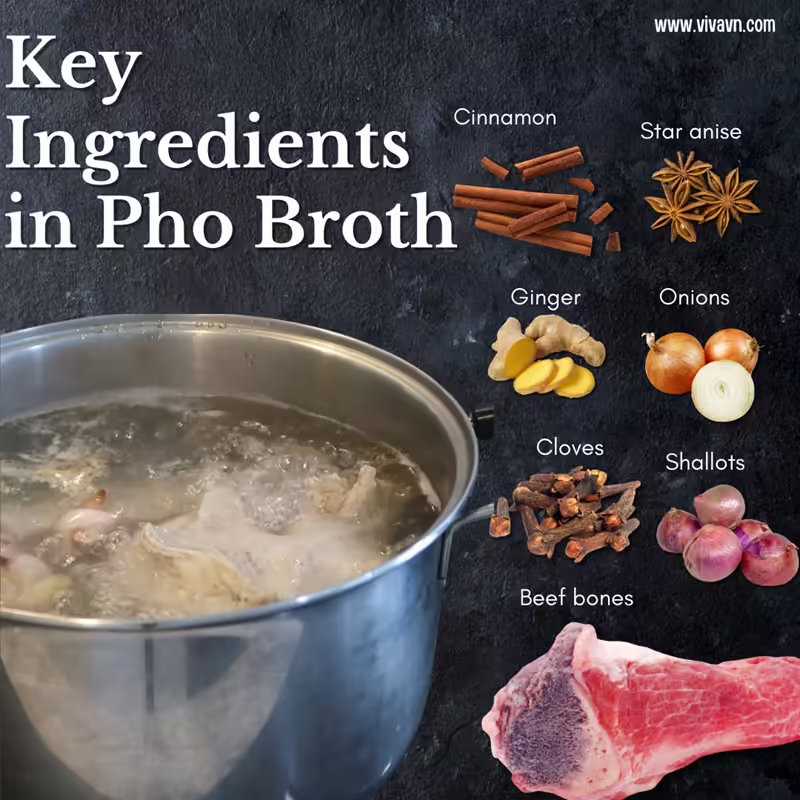
Pho vs Bun Bo Hue: A Simple Guide to the Differences for Beginners
Pho and bun bo Hue are two of Vietnam’s most delicious dishes, but they each have their own unique twist. If you’re new to Vietnamese food, don’t worry! In this article, we’ll break down the key differences between pho vs bun bo Hue, from the ingredients to the flavors, so you can easily see what makes each dish special.
What is pho?
What is bun bo Hue?
Key differences
Which one should you try first?
FAQs
What is pho?
Pho is a fragrant noodle soup that originated in Northern Vietnam but has become a favorite throughout the country and internationally. Typically, Pho is made with either beef (pho bo) or chicken (pho ga), accompanied by a savory broth that is infused with herbs and spices like star anise and cinnamon.
Key ingredients of pho:
Broth: Clear, light, and aromatic with flavors of cinnamon, cloves, and star anise. It has a mild, subtly sweet taste.
Noodles: Soft Flat rice noodles.
Toppings: Sliced beef or chicken, fresh herbs (such as Thai basil), lime, bean sprouts, and some optional seasonings.


What is bun bo Hue?
Bun bo Hue hails from the central region of Vietnam, specifically Hue, and is known for its bold, spicy flavors. Unlike pho, which has a more delicate taste, un bo Hue is rich in spices, often spicier, and comes with a more robust, savory broth.
Key ingredients of bun bo Hue:
Broth: Rich, spicy, and savory, flavored with lemongrass, shrimp paste, and chili. The broth is often darker and more intense than Pho’s.
Noodles: Round rice noodles.
Toppings: Includes a combination of beef, Vietnamese sausage, and pig’s blood cubes. Pork hock is often added for extra richness.


Key differences between Pho and Bun Bo Hue
Origin
Pho comes from northern Vietnam, where the food is known for its light and mild flavors. Bun bo Hue, on the other hand, is from Hue, the ancient capital of central Vietnam. The food in this region is famous for being bold and spicy, which is why Bun Bo Hue has a stronger, spicier taste. These regional differences give Pho and bun bo Hue their unique flavors.
Broth
If you take a closer look at the ingredients used to make the broths for pho and bun bo Hue, you’ll see how they shape the unique flavors of each dish. Bun Bo Hue is known for its bold, rich flavor, thanks to the use of a distinctive seasoning—fermented shrimp paste—and the fragrant aroma of lemongrass. On the other hand, Pho has a more subtle and comforting taste, infused with the warm spices of cinnamon, star anise, and cloves, commonly found in the cuisines of many countries.
Noodles
Bun and pho are both made from rice, but they differ in shape – bun is round, while pho is wide and flat.
Toppings
Pho is typically served with either beef or chicken, often accompanied by optional meatballs and fresh herbs. On the other hand, bun bo Hue features a variety of toppings, including beef, pork, congealed pork blood, Vietnamese sausage, pork hock, and fresh herbs.
Herbs on the side
Pho is often served with side herbs like Thai basil, cilantro, bean sprouts, and lime, while bun bo Hue comes with accompaniments such as fresh herbs, shredded banana blossoms, bean sprouts, and limes.
Visual appeal
Pho offers a simpler, cleaner presentation with a clear broth and minimal toppings, while bun bo Hue is vibrant and colorful, with red chili oil floating on the broth.

Pho vs bun bo Hue: Which one should you try first?
If you’re new to Vietnamese cuisine, we’d recommend starting with Pho. Its mild and balanced flavor is something most visitors from any country can enjoy, which is probably why it’s so popular worldwide. Once you’re familiar with Vietnamese food, you can move on to bun bo Hue, with its bold, spicy flavors.
We think people from countries where strong spices are commonly used in cooking will find Bun Bo Hue easy to enjoy right from the start.
FAQs
Pho vs Bun Bo Hue: Which is spicier?
Bun Bo Hue is generally a bit spicier. It comes from Central Vietnam, where spicy flavors are a signature of the local cuisine. However, if you’re not too fond of spice, you can always ask for a milder version.
What makes Pho different from Bun Bo Hue?
Pho and bun bo Hue are delicious Vietnamese dishes, but they differ. To help you see these differences clearly, we’ve outlined them in the table below. Check it out to better understand what sets these two dishes apart!
Origin
Broth Flavor
Noodles
Common Toppings
side herbs
Visual Appeal
Pho
Northern Vietnam
Mild, aromatic, subtly sweet
Flat rice noodles
Beef or chicken, fresh herbs, meatballs (optional)
Thai basil, cilantro, bean sprouts, and lime
A simpler, cleaner presentation
Bun bo Hue
Central Vietnam (Hue)
Bold, spicy, savory
Round rice noodles
Beef, Vietnamese sausage, pork hock, congealed pork blood, fresh herbs
Fresh herbs, shredded banana blossoms, bean sprouts
Vibrant and colorful

What kind of noodles do Pho and Bun Bo Hue use?
Pho uses wide, flat rice noodles, while Bun bo Hue is made with thinner, round rice noodles.

Share on FacebookShare on X (Twitter)Share on PinterestShare on WhatsappShare on LinkedinShare on TelegramShare on Email
- https://www.youtube.com/@VivaVNOfficial
- https://www.facebook.com/vivavnofficial2024
- https://www.pinterest.com/vivavnofficial/
© 2025 VivaVN. All rights reserved.

Leave a Reply